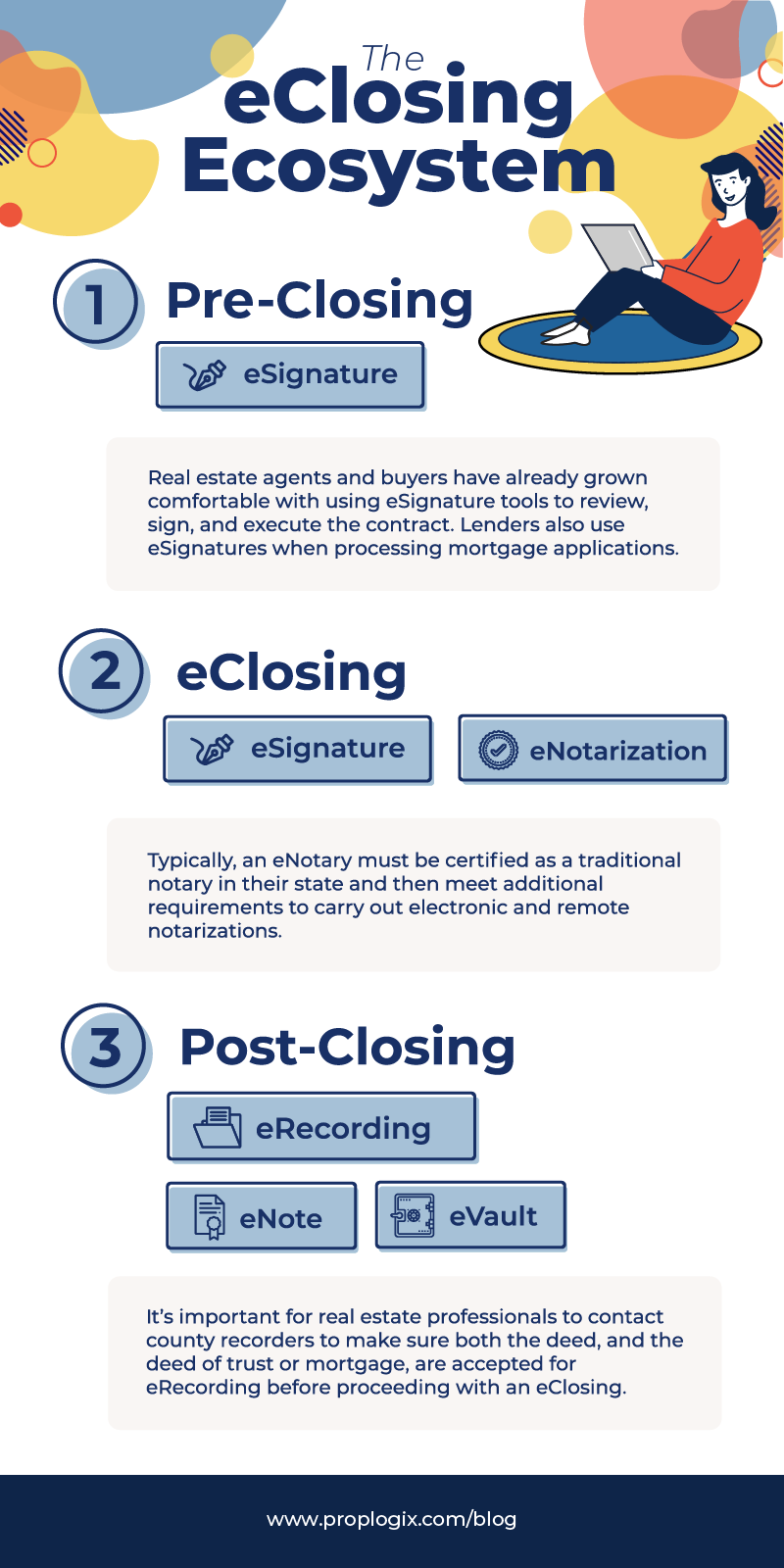Online shopping experiences helmed by eCommerce giants like Amazon have changed the way we think about every purchasing experience in our lives. This leaves many to wonder: If we can buy a car with a click of a button, why not a house? For those working in real estate, it’s easy to scoff at the idea because you know how much work goes on in the background. Pairing automation with legal requirements guiding the financial services, title insurance industry, and other professionals involved in a real estate transaction may sound like a waking nightmare to some.
For those of you who think it’s a dream worth pursuing, here’s an important breakdown of all the moving pieces of an eClosing. There are lots of stakeholders and tools involved in the eClosing ecosystem, so be sure to strike the right balance between all of them before introducing a new tool to your closing process.
Pre-Closing
Who is involved? Buyers, sellers, real estate agents, mortgage loan officers, and settlement agents
Tool: eSign or eSignature
Real estate agents and buyers have already grown comfortable with using eSignature tools to review, sign, and execute the contract. In this way, the pre-closing stage is an extension of a process that most consumers are already familiar with.
Some of the positive impacts of using eSignature tools in real estate deals include:
- Less stress for buyers. Receiving the documents that don’t require a wet signature or notary seal before the closing means there is plenty of time to review and understand the documents they are signing. Any questions can be answered by the appropriate professionals to reduce time spent at the closing.
- Reduces errors. There are built-in fail-safes within eSignature tools to ensure no initials or signatures are missed. It also lowers the likelihood of losing documents before submitting them for recordation.
- Reduces costs. Fewer errors mean that title companies will no longer have to rush deliveries of documents with missing signatures after closing. This reduces closing times and costs considerably.
- Mobility. Software that enables eSignatures are browser-based or easily downloaded onto devices that real estate and title professionals can take with them anywhere. Real estate agents can draw up contracts on the spot and have buyers sign via a tablet or smartphone at a time that’s convenient for them.
- Eliminates clutter. A traditional real estate closing involves mounds of paper documents. Compiling these documents in electronic form will help real estate agents and settlement agents better manage, store, and retrieve them when needed. Less shuffling through physical documents means a more seamless closing and a better experience for your customers.
- Legally binding. The Electronic Signatures in Global and National Commerce Act (ESIGN) allows states to craft their own laws and guidance on electronic signatures as long as it adopts the model Uniform Electronic Transactions (UETA) or the laws are consistent with ESIGN and remain technology-neutral. As a result, all states have similar laws that give legal effect to electronic signatures, contracts, records, and transactions.
eSignature Software
Federal and state laws that regulate electronic signatures don’t recommend what software to use. There are some important requirements, however, that these technological solutions must follow.
Some common state UETA requirements include:
- Consumer consent must be obtained to use electronic signatures or records. Some states have additional requirements on how consumer consent is obtained and delivered by insurance businesses.
- Disclosures must be delivered to consumers that provide clear statements on the procedures of using and storing electronic data.
- Evidence of the signer’s intent to sign.
- A visual display or image of the signer’s signature must be affixed to the documents.
- Recipients of electronic documents must be able to print and store it. If an eSignature software doesn’t permit the ability to do so, it’s not an acceptable eClosing solution.
- eSignature solutions must also be able to attribute the signature and record to an individual. In an audit, the eSignature must be:
- Authenticated
- Unique
- Attributed solely to the signer
- Tamper-evident, meaning that it’s encrypted in such a way that any alteration will invalidate the eSignature
Settlement agents have been preparing electronic documents for signatures in hybrid closings for some time now, reducing the time spent at the closing table later. Adoption of eSignature technology in the closing process is the first step to a fully digital closing.
The eClosing Process
Who is involved? Buyer, Seller, Settlement agent, loan signing agent, mortgage lender
Tool: eNotarization or “Digital Closing Room” platforms
While the COVID-19 pandemic has pushed the adoption of remote online closing forward in many states, it’s important to distinguish between RON and RIN closings. RIN stands for Remote Ink-signed Notarization and is a term coined by Fannie Mae to differentiate between a true RON closing and the temporary approval via executive orders of paper closings with the aid of audio-visual technology.
The main difference between these two closings is that a RIN closing has no eNotary component. The eNotarization is a crucial piece in executing a true digital closing. Essential real estate transaction documents, like the deed, the mortgage, and deed of trust, require a notary seal, so without eNotarization, only a hybrid closing is possible.
Laws for remote online notarization are passed at the state level and regulations and implementation of the technology are developed by the Secretaries of State. Typically, an eNotary must be certified as a traditional notary in their state and then meet additional requirements, like RON certifications, additional bonds, and maintain electronic records, to carry out electronic and remote notarization.
Legal requirements for Remote Online Notarization Technology
The tools used in eNotarization must meet many of the same requirements of eSignature technology. However, because the notarial ceremony requires specific and additional duties of the notary, RON platforms must provide features to support these requirements.
When reviewing these platforms, there are 5 important questions to ask:
- Does it gather consent from all parties and provide disclosure of the fact of remote online notarization in the notarial certificate?
- Does it provide multi-factor or multi-layered authentication for signers i.e. presentation and scanning of government-issued identification, knowledge-based authentication questions, and other identity proofing?
- Does it provide uninterrupted audio and video recording of the notarial ceremony that can be securely stored for the length of time required by your state’s law?
- Does it create tamper-evident seals on executed documents and a clear audit trail of the sequence of activities taken on each document?
- Does it abide by privacy laws to protect non-public information (NPI) and include security procedures and processes to prevent unauthorized access both during the real estate transaction and any recordings stored after the fact?
Other considerations when choosing a remote online notarization platform should be:
- the level of flexibility to use your own notary and/or loan signing agent
- and customer support
There are several options available today, and some may be better suited for your clients than others. Take the time to review as many as possible before committing to one and consider what the user experience for your buyer and seller will be like. Is it easy to use? Is it intuitive? Does it reflect the flow of a traditional signing?
Post-Closing
Who’s involved? Settlement agents, lenders, county recorders
Tools: eRecording and eNote/eVault
While the remote online notarization component of eClosing has become the talk of the town lately, the post-closing components are just as important in order to execute an eClosing.
That includes:
- eRecording
- eNote
- eVault
eRecording
The Property Records Industry Association (PRIA) defines eRecording as a “method of delivering and returning documents electronically from a submitter to the recorder.” While the “e” gives the perception that the process is paper-free, that’s not always the case. Many settlement agents use a “paper out” method to complete the eRecording where paper originals with wet ink signatures are sent to the county recorder as an image, like a fax. There are also additional manual steps taken by the recorder to process the eRecording on their end.
eRecording has a lot of the same time and cost-saving benefits as other eClosing tools. It especially helps settlement agents comply with Pillar Four of American Land Title Association’s Best Practices, which suggests submitted documents for recording by the end of the second day following the date of Settlement by completing this step quickly after closing.
Without it, a truly paper-free and digital closing isn’t possible, so it’s important for settlement agents and real estate professionals to contact county recorders to make sure both the deed, and the deed of trust or mortgage, are accepted for eRecording before proceeding with an eClosing.
If the county recorder refuses to accept any documents from the real estate transaction via eRecording, this will impact your workflow, the order of document submissions, and potentially the gap period. Be sure to speak with your underwriter if you’re unsure of how to proceed and the effect it may have on the policies you issue.
eNote & eVault
The final component of an eClosing ecosystem is the creation of the eNote and its storage within an eVault. An eNote is an electronic version of the promissory note that has been eSigned. For lenders, this is an essential aspect of the digital mortgage strategy to lower costs and improve the consumer experience.
eNotes don’t require notarization, are enforceable in all 50 states, and serve as a transferable and authoritative promissory note.
Once created, the eNote is stored in an eVault much like a physical vault with the added benefit of reducing costs, eliminating the need for “lost note” affidavits filed in foreclosure proceedings, and increased speed in completing mortgage originations and secondary market transactions.
eVault solutions may be provided by a RON or eClosing platform or a lender may use a separate third-party vendor specifically tasked with securing and storing eNotes. eVault technology is the only way to interface with the MERS eRegistry, which is the legal system of record identifying the Controller (the party with the legal right to enforce the eNote) and the Location (the party who is responsible for maintenance of the authoritative copy of the eNote and any electronic documents modifying the eNote) of the original eNote.
Hurdles to eClosings
In addition to considering consumer experience and integration into current internal workflows, settlement agents, notaries, and real estate lawyers looking to adopt eClosing solutions should consider lender requirements. Since Fannie Mae and Freddie Mac are the largest purchasers of eNotes, it makes sense to review the Fannie Mae eClosing Technology Service Provider List.
The biggest hurdle to this final step has been the acceptance of eNotes on the secondary mortgage market, but since GSEs like Fannie Mae and Freddie Mac have begun to accept them, more and more private lenders are following suit. The MERS eRegistry provides lenders and investors independent third-party verification of the legitimacy of eNotes.
In the first quarter of 2019, about 19,000 eNotes were registered on the MERS eRegistry compared to 17,000 eNotes registered in all of 2018. These numbers reflect a change in attitude regarding the acceptance of eNotes and greater confidence in the eClosing ecosystem.
To learn more about the benefits of eClosing solutions for settlement agents and tips to get started, listen to this interview with Danielle Kaiser from NATIC on digital closings.











